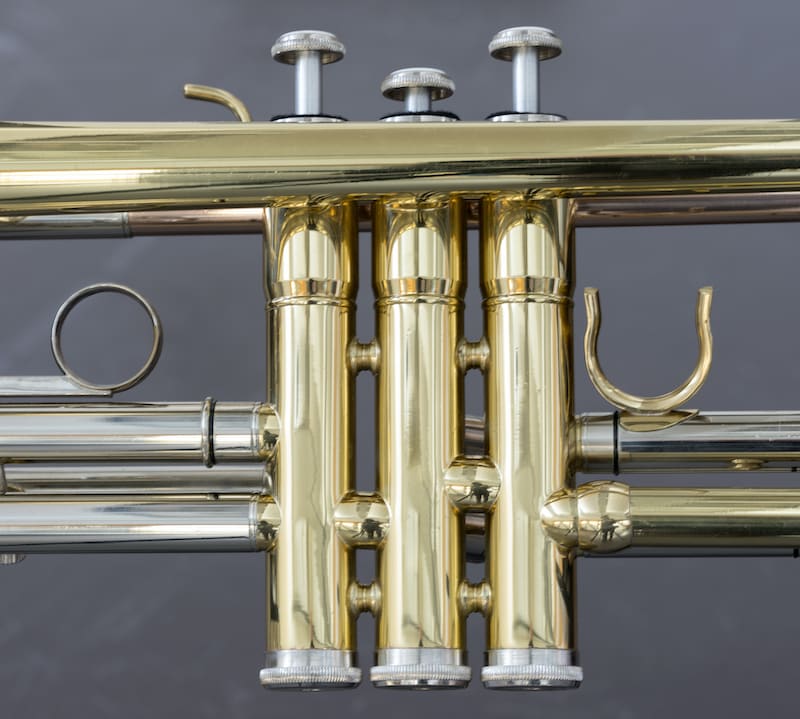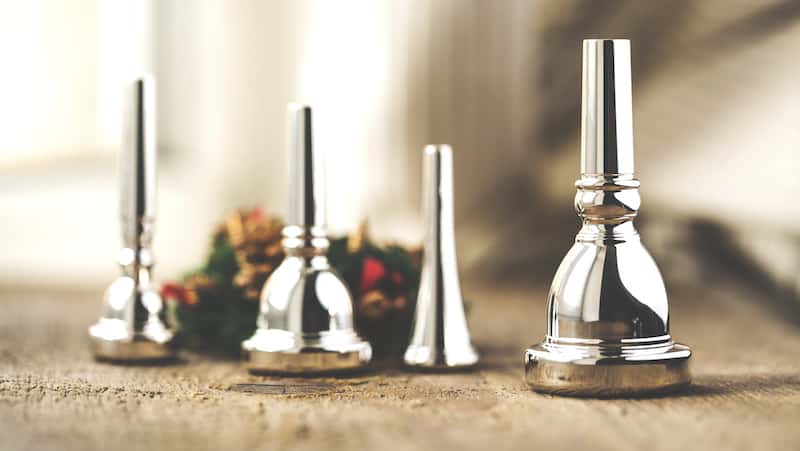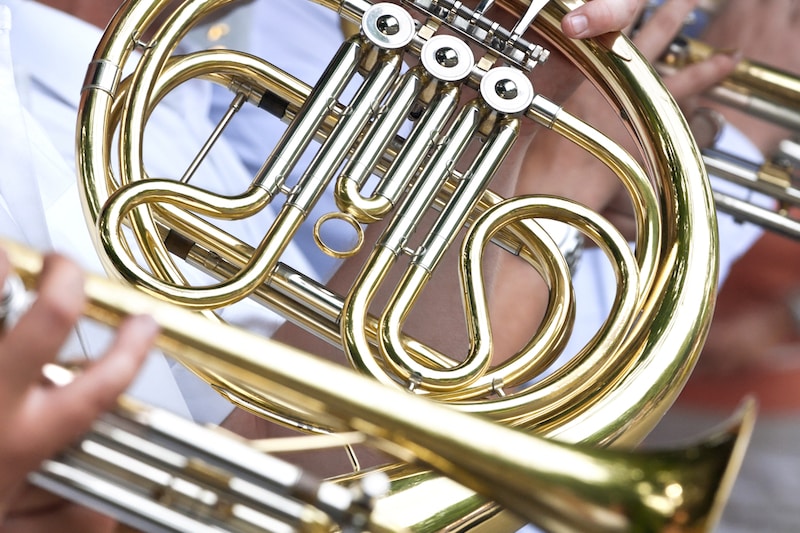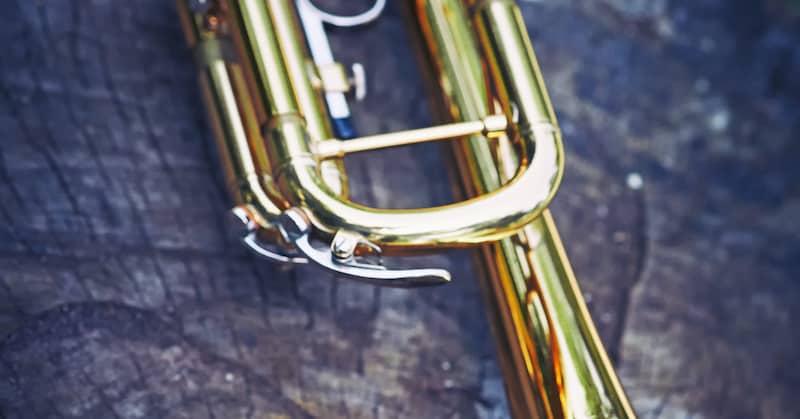Both brass instruments, the French horn and trumpet share a lot of similarities. They both require an embouchure to create the sound and they are both used in symphonies, military bands, jazz orchestras, etc. However, there are some significant differences between the two that every musician should know before choosing which instrument to play.
In this post, we’re going to answer the question, what’s the difference between the french horn and explore what they do, and don’t, have in common.
Similarities Between the Trumpet and French Horn
Other than being members of the Brass family, the trumpet and the horn share a number of different similarities.
They’re Both Made of Brass
As the name of this family of instruments indicates, trumpets and french horns both contain brass.
These instruments, polished with lacquer to prevent corrosion, are sometimes plated with gold or silver.
In place of brass, the instruments include alloys that contain high amounts of copper or silver.
They are Played with the Same Technique
Like their low brass siblings, both french horn and trumpet players play their instruments in the same way.
This involves blowing into their instruments and vibrating their lips, known as buzzing, into a metal cup-shaped or funnel-shaped mouthpiece.
The air then travels through the coiled tubing and exits the instrument via a flared bell.
They Both Have Three Valves

The trumpet and the single horn both have three valves.
These are mechanical systems that help change the pitch of the instrument when they’re pressed down in different combinations.
They Sit Together in an Orchestra
You can find these instruments in a small brass ensemble, concert/symphonic band, and orchestras.
In orchestra and concert band scores, trumpets, horns, and the rest of the brass are placed below the woodwinds.
They’re Both Transposing Instruments
The trumpet and french horn are types of transposing instruments which means the notes they read actually sound a different note.
Sometimes, the horn and trumpet players are called on to transpose their music on sight to match the key of the music played by the ensemble.
Transposing is often used in orchestral pieces written before the 19th century or in the cases in which other music written in concert pitched C when a transposed part is unavailable.
You Have to Practice Them Regularly
If a trumpet or French horn player does not practice for a few days, weeks or months, the embouchure of the lips becomes weakened and as a result, its endurance and upper tonal range becomes lost.
Brass players especially have to play often to prevent losing their “chops”.
They Both Produce Condensation when Playing
It’s a bit gross, especially if you’ve not seen it before, but like their other brass instruments in the brass family, the trumpet and horn form condensation when they’re being played.
This is due to the warm air blowing through them when the musician plays them.
This condensation needs to be emptied from the instrument to avoid a gurgly sound a
They can Both Be Muted

Both trumpets and french horns can be muted to make the sound that comes out of them quieter.
This involves the musician placing their hand or various special mutes in the instrument’s bell to mute the instruments for a quiet or more mysterious effect.
There are lots of different types of mutes for both instruments each with its own sound depending on what the player wants to achieve.
The Differences Between the Trumpet and Horn Include
Now that we’ve looked at some of the things the two instruments have in common, it’s time to explore some of their differences and what sets the trumpet and french horn apart.
They Have Different Mouthpieces

The first obvious difference is in their mouthpieces.
Horn mouthpieces have a deep funnel shape, whereas trumpet mouthpieces have a shallower cup shape.
The rims on a horn mouthpiece are thinner and it includes a longer and narrower shank.
In fact, the mouthpiece of a French horn is smaller than a trumpet, making it the smallest of all brass instruments.
They use Different Types of Valves

Although they look very similar, trumpets and french horns actually use different types of valves that are pressed down to change the pitch of notes.
The typical horn used in orchestras today is a double horn and has four rotary valves.
Whereas the trumpet has three piston valves.
Another difference to do with the valves is which hand the musician uses to press the valves.
Typically, a trumpet player operates their valves with their right hand, while horn players operate their valves with their left hand.
They are Different Lengths
Due to the way that the tubing is coiled, brass instruments are deceptively longer than they look.
It’s also a big difference between the two instruments and the horn is considerably longer when uncoiled.
A single horn measures up to 13 feet, and a double horn can measure up to 22 1/2 feet when uncoiled.
That’s in contrast to a standard Bb trumpet which measures 4 feet, 10 inches when uncoiled.
Due to their lengths uncoiled, the horn coils into a circular shape with various slides, while the trumpet is folded twice into an oblong shape.
They are in Different Keys
Today’s standard horn is pitched in the Key of F, while the standard trumpet is in the key of Bb.
In a piece of music, when a trumpet player plays the note of C on their instrument, it actually sounds a concert Bb note.
But, when a horn player plays the note of C on theirs, it actually sounds a concert F note.
They have Different Ranges

The comprehensive range of a trumpet is two and a half to three octaves.
But, the french horn has four octaves giving the instrument the most extensive range of all brass instruments.
A horn player can reach notes as low as a bass trombone or tuba with its tremendous range, and some orchestra parts have sections written in the bass clef.
With its shorter length, the trumpet can reach brilliant high passages and lead trumpet players can play extremely high-pitched notes.
As well as the ranges being different another way they differ is what’s known as partials.
In the horn’s most comfortable range, it is easier to miss or “bauble” a note due to the closeness of partials, known as the available notes in the harmonic series and it is more challenging to find those pitches.
Conversely, the partials on a trumpet in its comfortable range are further apart so it’s harder to miss them.
They Empty Condensation Differently

The emptying of condensation between the trumpet and horn is another way the two brass instruments are different.
While condensation collected inside a trumpet leaves via a water key, the horn, with its many crooks, has many places in which it hides.
The hornist empties their horn by pulling some of the crooks out and ridding the horn of its condensation, using the water key if available, or maneuvering the horn to remove it quickly.
They’re used in Different Music Groups
Even though trumpets and horns play in orchestras, concert bands, and brass ensembles together, they traditionally play in different music groups.
Even though the French horn is a brass instrument, they reside and add tonal color in woodwind chamber groups such as quintets and octets.
Trumpets on the other hand are often seen in jazz ensembles, mariachi, R&B, and occasional rock bands.
In place of bugles, trumpet players perform taps for military funerals with trumpets.
As well as being found in different music settings, their uses in marching bands and the modern drum and bugle corps are different.
With the trumpet being a bell front instrument, it is an easy fit in any marching ensemble.
However, the commonly used concert horn, with its shape, backward-facing bell, and sound direction, makes it awkward for the musician to play on the field and in parades.
To solve this problem, the hornist plays a marching French horn or mellophone in marching ensembles.
These bell front instruments project the sound toward the player’s front instead of the player’s back.
An Orchestra Has Different Number of Players
The number of players in each section differs in the standard full orchestra.
For example, you’ll typically find two to three trumpet players in a full orchestra, while the average number of horn players is between four to five.
They Made Their Orchestral Debuts at Different Times
Although they share a similar history, the two instruments had a bit of a gap between when they made their first orchestral debuts.
The trumpet made its first orchestral appearance in 1607 for Italian composer Claudio Monteverdi’s opera Orfeo.
The french horn on the other hand made its first orchestral appearance in well-known French composer Jean Baptiste Lully’s ballet, Zephire Et Flore, in 1664.
Conclusion
As you can see, there are a lot of things in common between the two instruments while also having some very large differences.
We hope this has helped you understand some of the differences between these two instruments.

